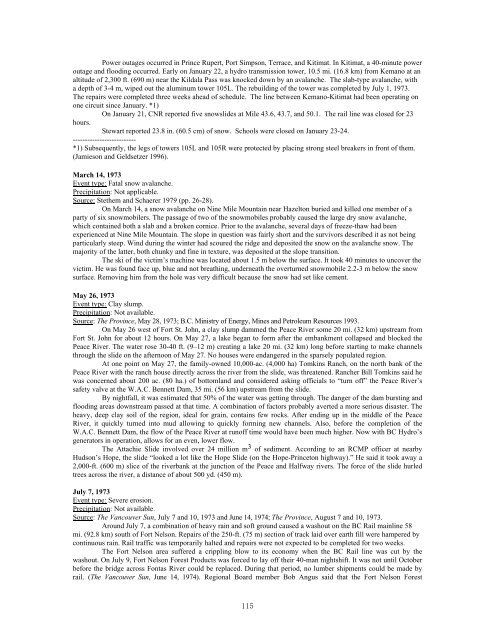HISTORICAL NEWS SEARCH - Government of British Columbia
HISTORICAL NEWS SEARCH - Government of British Columbia
HISTORICAL NEWS SEARCH - Government of British Columbia
Create successful ePaper yourself
Turn your PDF publications into a flip-book with our unique Google optimized e-Paper software.
Power outages occurred in Prince Rupert, Port Simpson, Terrace, and Kitimat. In Kitimat, a 40-minute power<br />
outage and flooding occurred. Early on January 22, a hydro transmission tower, 10.5 mi. (16.8 km) from Kemano at an<br />
altitude <strong>of</strong> 2,300 ft. (690 m) near the Kildala Pass was knocked down by an avalanche. The slab-type avalanche, with<br />
a depth <strong>of</strong> 3-4 m, wiped out the aluminum tower 105L. The rebuilding <strong>of</strong> the tower was completed by July 1, 1973.<br />
The repairs were completed three weeks ahead <strong>of</strong> schedule. The line between Kemano-Kitimat had been operating on<br />
one circuit since January. *1)<br />
On January 21, CNR reported five snowslides at Mile 43.6, 43.7, and 50.1. The rail line was closed for 23<br />
hours.<br />
Stewart reported 23.8 in. (60.5 cm) <strong>of</strong> snow. Schools were closed on January 23-24.<br />
--------------------------<br />
*1) Subsequently, the legs <strong>of</strong> towers 105L and 105R were protected by placing strong steel breakers in front <strong>of</strong> them.<br />
(Jamieson and Geldsetzer 1996).<br />
March 14, 1973<br />
Event type: Fatal snow avalanche.<br />
Precipitation: Not applicable.<br />
Source: Stethem and Schaerer 1979 (pp. 26-28).<br />
On March 14, a snow avalanche on Nine Mile Mountain near Hazelton buried and killed one member <strong>of</strong> a<br />
party <strong>of</strong> six snowmobilers. The passage <strong>of</strong> two <strong>of</strong> the snowmobiles probably caused the large dry snow avalanche,<br />
which contained both a slab and a broken cornice. Prior to the avalanche, several days <strong>of</strong> freeze-thaw had been<br />
experienced at Nine Mile Mountain. The slope in question was fairly short and the survivors described it as not being<br />
particularly steep. Wind during the winter had scoured the ridge and deposited the snow on the avalanche snow. The<br />
majority <strong>of</strong> the latter, both chunky and fine in texture, was deposited at the slope transition.<br />
The ski <strong>of</strong> the victim’s machine was located about 1.5 m below the surface. It took 40 minutes to uncover the<br />
victim. He was found face up, blue and not breathing, underneath the overturned snowmobile 2.2-3 m below the snow<br />
surface. Removing him from the hole was very difficult because the snow had set like cement.<br />
May 26, 1973<br />
Event type: Clay slump.<br />
Precipitation: Not available.<br />
Source: The Province, May 28, 1973; B.C. Ministry <strong>of</strong> Energy, Mines and Petroleum Resources 1993.<br />
On May 26 west <strong>of</strong> Fort St. John, a clay slump dammed the Peace River some 20 mi. (32 km) upstream from<br />
Fort St. John for about 12 hours. On May 27, a lake began to form after the embankment collapsed and blocked the<br />
Peace River. The water rose 30-40 ft. (9–12 m) creating a lake 20 mi. (32 km) long before starting to make channels<br />
through the slide on the afternoon <strong>of</strong> May 27. No houses were endangered in the sparsely populated region.<br />
At one point on May 27, the family-owned 10,000-ac. (4,000 ha) Tomkins Ranch, on the north bank <strong>of</strong> the<br />
Peace River with the ranch house directly across the river from the slide, was threatened. Rancher Bill Tomkins said he<br />
was concerned about 200 ac. (80 ha.) <strong>of</strong> bottomland and considered asking <strong>of</strong>ficials to “turn <strong>of</strong>f” the Peace River’s<br />
safety valve at the W.A.C. Bennett Dam, 35 mi. (56 km) upstream from the slide.<br />
By nightfall, it was estimated that 50% <strong>of</strong> the water was getting through. The danger <strong>of</strong> the dam bursting and<br />
flooding areas downstream passed at that time. A combination <strong>of</strong> factors probably averted a more serious disaster. The<br />
heavy, deep clay soil <strong>of</strong> the region, ideal for grain, contains few rocks. After ending up in the middle <strong>of</strong> the Peace<br />
River, it quickly turned into mud allowing to quickly forming new channels. Also, before the completion <strong>of</strong> the<br />
W.A.C. Bennett Dam, the flow <strong>of</strong> the Peace River at run<strong>of</strong>f time would have been much higher. Now with BC Hydro’s<br />
generators in operation, allows for an even, lower flow.<br />
The Attachie Slide involved over 24 million m 3 <strong>of</strong> sediment. According to an RCMP <strong>of</strong>ficer at nearby<br />
Hudson’s Hope, the slide “looked a lot like the Hope Slide (on the Hope-Princeton highway).” He said it took away a<br />
2,000-ft. (600 m) slice <strong>of</strong> the riverbank at the junction <strong>of</strong> the Peace and Halfway rivers. The force <strong>of</strong> the slide hurled<br />
trees across the river, a distance <strong>of</strong> about 500 yd. (450 m).<br />
July 7, 1973<br />
Event type: Severe erosion.<br />
Precipitation: Not available.<br />
Source: The Vancouver Sun, July 7 and 10, 1973 and June 14, 1974; The Province, August 7 and 10, 1973.<br />
Around July 7, a combination <strong>of</strong> heavy rain and s<strong>of</strong>t ground caused a washout on the BC Rail mainline 58<br />
mi. (92.8 km) south <strong>of</strong> Fort Nelson. Repairs <strong>of</strong> the 250-ft. (75 m) section <strong>of</strong> track laid over earth fill were hampered by<br />
continuous rain. Rail traffic was temporarily halted and repairs were not expected to be completed for two weeks.<br />
The Fort Nelson area suffered a crippling blow to its economy when the BC Rail line was cut by the<br />
washout. On July 9, Fort Nelson Forest Products was forced to lay <strong>of</strong>f their 40-man nightshift. It was not until October<br />
before the bridge across Fontas River could be replaced. During that period, no lumber shipments could be made by<br />
rail. (The Vancouver Sun, June 14, 1974). Regional Board member Bob Angus said that the Fort Nelson Forest<br />
115

















